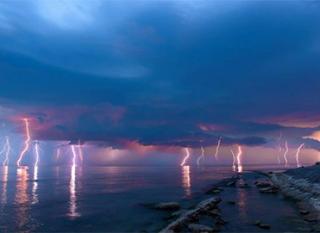Simply stated - probably not! Not entirely anyway. This is due to basic scientific principles surrounding the nature of lightning. High-frequency electricity, such as those from lightning strikes, transfers very quickly from one wire to another without a direct electrical connection. This is known as electromagnetic induction. As the electrical current passes through one wire, it will continue on a path passing into any wire close to it.
Roughly translated, lightning that strikes a boat will continue to spark, jumping from one conducting object to the next. Boaters call the process "side flashing" because it describes the way the current makes its way through galley appliances, water tanks, engine blocks and possibly people, until it reaches the water.
You should know that according to stats released by Boat US Marine Insurance, the odds of your boat being struck by lightning in any calendar year are about 1 in 700,000. For people who have boats in Florida, however, the odds become significantly greater. The strike rate in Florida is 3.3 boats per 1,000. It is also worth noting that 33% of all lightning claims for USBoat Marine Insurance claims are from the Sunshine State!
Repairs from lightning strikes are generally time-consuming and usually quite expensive. So, what can you do to protect yourself and your boat?
Most sport fishing boats, like L&H Boats’ Walkarounds, as well as production and custom yachts, are properly bonded, meaning all underwater metal fittings and large metal objects are tied together electrically. Bonding collects and routes the lightning’s energy safely. A well-maintained bonding system tied to at least one square foot of underwater metal typically protects people and prevents fire and structural damage.
Installing a lightning protection system on the boat is not uncommon and reflects safe boating standards. Your boat should be built by a well-known and reputable company, and an equally reputable company should be utilized in the installation of the tower and outriggers. A boat will always be a better conductor than air, so if the lightning is near enough to a strike, the boat will become part of the strike if an appropriate alternate path to ground is not provided.
When the “side flashes” are close enough to the water to overcome the resistance of the air, they will jump directly to the water and through anything in their way. Tying large metal objects together via the ship’s bonding system helps prevent side flashes. L&H Boats professionals strongly recommend running main lightning conductors out near the hull sides, not down the boat’s center. Adding multiple exit terminals around the boat will create a series of conductors around the outside of the boat that essentially form a cage. People and equipment inside that cage are all at the same voltage, and therefore protected.
Lightning is unpredictable. While you can mitigate the damage from a lightning strike, there is nothing you can do to prevent one. So, read up, and acquire as much knowledge and information as you can. Be sure you take every safety precaution and you will want to purchase the best insurance policy available.
If you do get hit, damage will need to be assessed and corrected. Even boaters fortunate enough to come away totally unscathed following a lightning storm, should still have a professional inspection done just to be sure. Minor damage to through-hulls can result in slow leaks, and all sorts of electrical problems can appear sometime later. It’s better to catch these issues right after the strike and get that information to the insurance company as soon as possible.


